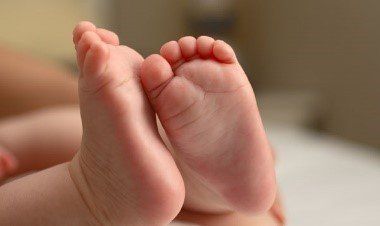Foot Health and Children
Children’s feet differ from adults, as they are not yet fully formed. At 6 months of age, the foot is still mostly cartilage, in fact the last bone doesn’t begin forming until children are about 3 years old. By the time we turn 18, the bones have fully matured.

Baby’s feet only need protection in the cooler weather. Play suits with feet, socks, or even natural fibre shoes can be used to keep little feet warm, they should always be loose around your baby’s feet. Allowing your baby to kick freely, will help with muscle development in their legs and feet.
Children begin to walk anytime between 10 and 20 months of age. It is important to remember that each child is unique and will move through the different development stages at their own pace. There is no evidence that the use of Jolly Jumpers or baby walkers will encourage your baby to walk before they are ready, however these types of equipment may place additional pressure on feet that are not yet ready for taking weight.
Sometimes children walk with their feet pointed inwards (in-toeing) or outwards (out-toeing). In most cases, these variations in walking are a normal part of growth and development and most children will grow out of these walking styles by the age of 2, however it can take until the age of 12! Children under the age of 3 sometimes walk on their tiptoes, and this is a typical development stage, however any child over the age of 3 who is still tiptoe walking should be assessed by a Podiatrist.
Due to the rapid growth in length and width of young feet, frequent changes in the size of shoes and socks are necessary. Do a size check at least every 1 – 3 months up to the age of 3 and every 4 months up to the age of 5, then every 6 months until your child stops growing!
If your child has pain walking, or a foot that looks different to their other foot, a podiatrist can assist!
Problems with skin and nails on your child’s feet may occur from time to time. Some conditions such as ingrown toenails, athlete’s foot and warts, may require treatment from a podiatrist. Children also tend to be more susceptible to warts than adults. A plantar wart is often on the sole of the foot, it appears hard and flat, with a rough surface and well defined boundaries. If the wart is causing discomfort, a podiatrist can assist with treatment.
Please see your podiatrist if you notice any of the following –
- Uneven shoe wear
- Skin rashes, hard skin lumps or bumps on your child’s feet
- Recurrent pain in the feet or legs, which increases with activity
- Your child walks on their tiptoes
- Your child’s walk does not look symmetrical
- You have any other concerns about your child’s feet.

